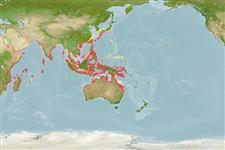Common names from other countries
Classification / Names / Names
Namen | Synonyme | Catalog of Fishes (gen., sp.) | ITIS | CoL | WoRMS
Environment: milieu / climate zone / depth range / distribution range
Ökologie
Riff-verbunden; tiefenbereich 0 - 12 m (Ref. 100949). Tropical
Indo-West Pacific.
Length at first maturity / Size / Gewicht / Alter
Maturity: Lm ? range ? - ? cm Max length : 8.0 cm SHL Männchen/unbestimmt; (Ref. 349); common length : 6.0 cm SHL Männchen/unbestimmt; (Ref. 349)
Regularly collected for food and shellcraft in many countries of the Indo-West Pacific area (Ref. 349). Among rocks and under stones, in rocky shores. Also found in shallow subtidal depths. Sometimes very common (Ref. 349). Feeds on epilithic algae by grazing (Ref. 85382). Found in intertidal, on rocks (Ref. 75835).
Life cycle and mating behavior
Geschlechtsreife | Fortpflanzung | Ablaichen | Eier | Fecundity | Larven
Members of the order Patellogastropoda are mostly gonochoric and broadcast spawners. Life cycle: Embryos develop into planktonic trocophore larvae and later into juvenile veligers before becoming fully grown adults.
Poutiers, J.M. 1998. (Ref. 349)
IUCN Rote Liste Status (Ref. 130435)
CITES Status (Ref. 108899)
Not Evaluated
Not Evaluated
Bedrohung für Menschen
Harmless
Nutzung durch Menschen
Fischereien: kommerziell
| FishSource |
Tools
Mehr Information
Alter/Größe
Wachstum
Länge-Gewicht
Länge-Länge
Morphologie
Larven
Dichte
Internet Quellen
Estimates based on models
Preferred temperature
(Ref.
115969): 24.8 - 29.3, mean 28.5 (based on 2592 cells).
Verwundbarkeit
Low vulnerability (10 of 100).
